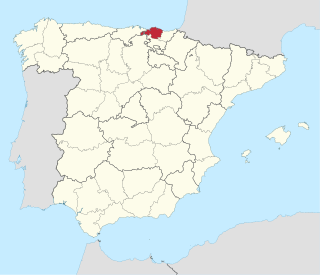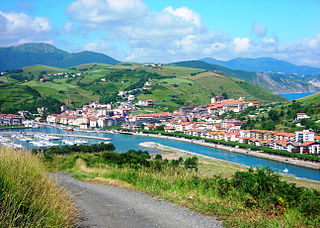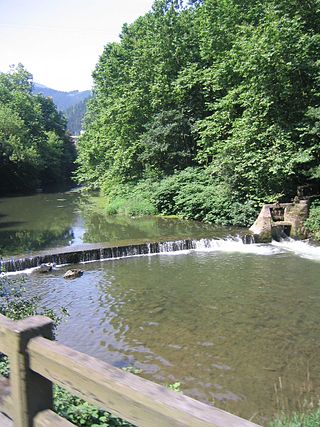
Biscay is a province of Spain and a historical territory of the Basque Country, heir of the ancient Lordship of Biscay, lying on the south shore of the eponymous bay. The capital and largest city is Bilbao.

Zumaia is a small town in the north of Spain in the Basque Country.

Gipuzkoa is a province of Spain and a historical territory of the autonomous community of the Basque Country. Its capital city is Donostia-San Sebastián. Gipuzkoa shares borders with the French department of Pyrénées-Atlantiques at the northeast, with the province and autonomous community of Navarre at east, Biscay at west, Álava at southwest and the Bay of Biscay to its north. It is located at the easternmost extreme of the Cantabric Sea, in the Bay of Biscay. It has 66 kilometres of coast land.

The Urola is a river and valley in Gipuzkoa, Basque Autonomous Community, Spain.

Azpeitia is a town and municipality within the province of Gipuzkoa, in the Basque Country, Spain, located on the Urola river a few kilometres east of Azkoitia. Its population is 14,580. It is located 41 kilometres southwest of Donostia/San Sebastián.

Azkoitia is a town located in the province of Gipuzkoa, in the Autonomous Community of Basque Country, in northern Spain. It is also the seat of the municipality of the same name.

Usurbil is a town and region located in the province of Gipuzkoa in the Autonomous Community of the Basque Country, in the North of Spain.

Zarautz is a coastal town located in central Gipuzkoa, Basque Country, in Spain. It is bordered by Aia to the east and the south and Getaria to the west, located about 15 kilometres (9.3 mi) west of San Sebastián. It has four enclaves limiting the aforementioned municipalities: Alkortiaga, Ekano, Sola, and Arbestain. As of 2014, Zarautz has a population of 22,890, which usually swells to about 60,000 in the summer.

Elorrio is a town and a municipality located in the eastern part of the province of Biscay, in the Basque Country, in northern Spain. As of 2017, it has a population of 7,307 inhabitants. It covers an area of 37.20 square kilometers and it has a population density of 193.58 people per square kilometer. It holds the medieval title of Most Loyal and Noble Villa.

Getaria is a town on the Urola coast, in the province of Gipuzkoa, in the autonomous community of the Basque Country, in northern Spain. It borders Zarautz to the east and Zumaia to the west.
Gipuzkoan is a dialect of the Basque language spoken mainly in the central and eastern parts of the province of Gipuzkoa in Basque Country and also in the northernmost part of Navarre. It is a central dialect of Basque according to the traditional dialectal classification of the language based on research carried out by Lucien Bonaparte in the 19th century. He included varieties spoken in the Sakana and Burunda valleys also in the Gipuzkoan dialect, however this approach has been disputed by modern Basque linguists.

Hernani is a town and municipality located in the province of Gipuzkoa, Basque Autonomous Community, Spain. The town sits on the left bank of the Urumea river. It is located at a distance of 9.2 km from San Sebastián. The municipality of Hernani occupies an area of approximately 40 square kilometres and is bordered by San Sebastián, Astigarraga, Arano, Elduayen, Errenteria, Lasarte-Oria and Urnieta.

Zumarraga is a municipality and industrial town in Gipuzkoa province of the Basque Country autonomous community of northern Spain, approximately 35 miles (56 km) by road southwest of San Sebastián and 10 miles (16 km) northwest of Idiazabal. As of 2018 the municipality had a population of 9834 people. The Urola river flows through the vicinity. It is the birthplace of Miguel López de Legazpi, conquistador who explored the Pacific Islands and the East Indies, and of Iñaki Urdangarín, the husband of Infanta Cristina of Spain.

Basque rural sports, known as Deportes Rurales in Spanish or Herri Kirolak in Basque, is the term used for a number of sports competitions rooted in the traditional lifestyles of the Basque people. The term force basque is used in French.

The Basques are an indigenous ethno-linguistic group mainly inhabiting the Basque Country. Their history is therefore interconnected with Spanish and French history and also with the history of many other past and present countries, particularly in Europe and the Americas, where a large number of their descendants keep attached to their roots, clustering around Basque clubs which are centers for Basque people.

The Basque Country, also called the Basque Autonomous Community, is an autonomous community in northern Spain. It includes the Basque provinces of Álava, Biscay, and Gipuzkoa. It also surrounds an enclave called Treviño, which belongs to the neighboring autonomous community of Castile and León.
The General Assemblies is the name of the legislative body (legislature) of the Spanish Basque territories of Biscay, Gipuzkoa, Alava and Navarre, and the elected assemblies to which the Government of each territory is responsible. The northern, French Basque Country, had its own regional assemblies until the Napoleonic period.

The physical geography of the Basque Country is very diverse despite the small size of the region. The territory hosts a blend of green and brown to yellowish tones, featuring hilly terrain altogether. The Basque Country spreads from the rough coastal landscape to the semi-desert of the Bardenas on the south-eastern fringes of Navarre.
Tourism in the Basque Autonomous Community has increased considerably in recent years, and is a popular destination for tourists from Spain and France. According to data from the Eustat the number of tourists entering the region in the year 2009 was 1,991,790, with the final result still pending. 71% of the yearly visitors come from the rest of Spain; the greatest number from Madrid Autonomous Community (14.2%), and Catalonia (11.1%). International visitors make up the remaining 29% - the largest percent come from France (7.2%). 62% of the people who come to the Basque Autonomous Community visit one of the three capitals, 27% visit inland and 11% visit the coast. The average stay of the visitors is 2 days.

The autonomous community of the Basque Country within Spain contains several comarcas or eskualdeak in the Basque language, referring to local districts, grouped into its three long-established provinces.



















